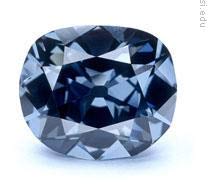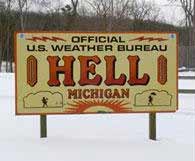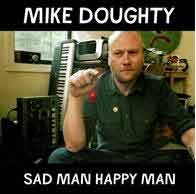HOST:
Welcome to AMERICAN MOSAIC in VOA Special English.
(MUSIC)
I'm Bob Doughty.
This week on our program... we play new music from singer/songwriter Mike Doughty...
And, answer a question about names of American towns, cities and states.
But first, some news about one of the most famous jewels in the world.
(MUSIC)
HOST:
The Hope Diamond is one of the largest and most famous jewels in the world. For 50 years, it has been in the collection of the Smithsonian's National Museum of Natural History in Washington, D.C. To mark this anniversary, the museum is showing the 45 carat blue diamond for the first time without its usual setting. Visitors can now see the Hope Diamond in all its natural beauty. Barbara Klein has more.
BARBARA KLEIN:
The Hope Diamond has a long and rich history. It was formed over a billion years ago far beneath the Earth's surface. Its rare blue color comes from small amounts of the element boron. The stone was discovered in a mine in India during the 17th century. It was more than 100 carats in weight. In 1668, the stone was sold to the ruler of France, King Louis the 14th.
A few years later, the king's jeweler recut the stone to a weight of about 67 carats. The stone was later lost during the French Revolution. A recut version of this blue diamond later reappeared in England.

Different families and jewelry experts have owned the stone over the years. The diamond received its name from one of its 19th century owners, Henry Phillip Hope. A wealthy American woman named Evalyn Walsh McLean bought the Hope Diamond in 1911. During her ownership the stone was placed in a setting surrounded by 16 small white diamonds on a long diamond chain.
Last month, the Smithsonian removed the Hope Diamond from this setting. Visitors can see the diamond all by itself, in all its sparkling blue glory. In April, the Hope Diamond will temporarily be placed in a new necklace before returning to its original setting. Also in April, the Smithsonian will release a new movie about the diamond's history.
The Hope Diamond is one of the most visited objects in the museum. Museum organizers say they wanted people to be able to see the famous stone in a new way.
Jeffrey Post is the curator of the museum's gem and mineral collection. He says seeing the Hope Diamond out of its setting also allows experts to study the rare stone. He said studying this jewel will help scientists learn more about diamonds in general.
(MUSIC)

HOST:
Our question this week comes from China. Li Wei wants to know why some American cities and states have the same name. For example, there is a New York City and a New York State. The same is true of the West Coast state of Washington and the East Coast city of Washington, D.C. And, there are more than ten other cities named Washington. They include those in Connecticut, Georgia, Indiana, Kansas, New Hampshire, North Carolina and Pennsylvania.
It is quite common for cities to have the same names as states. For example, there is a California, Maryland and an Iowa, Louisiana. There is a Florida, New York and a Kansas, Alabama.
Many names of American states and cities are based on Native American languages.
For example, the state of Alabama was named after a local Indian tribe called the the Alibamu. The word means "thicket clearers" or "herb gatherers." The state of Illinois comes from the Algonquian tribal word Illiniwek. It means "tribe of superior men." The states of North and South Dakota were both named for a group of Sioux Indians called Dakota. The word means "allies" or "friends."
Many American states are named after historic people. Georgia is the feminine Latin form of George and is named after King George the Second of Great Britain. Maryland was named after Queen Henrietta Maria, the wife of King Charles the First of England. And Louisiana is named in honor of King Louis the 14th of France.
But some names of cities and towns are unusual. Like Big Ugly, West Virginia and Idiotville, Oregon. Also, Sweet Lips, Tennessee and Kissimmee, Florida. There is Celebration in Florida and Santa Claus in Indiana. You could surely get something to drink in Hot Coffee, Mississippi. If you like animals, you might want to visit Monkey's Eyebrow, Arizona or Toad Suck, Arkansas, but not Deadhorse, Alaska. And you might decide you would rather live in Happy, Texas than in Hell, Michigan.
(MUSIC)
HOST:

Singer and songwriter Mike Doughty keeps it simple on his new CD "Sad Man Happy Man." The CD is free of the fancy production tricks common to many studio albums. Instead, you can hear Mike Doughty's unusual voice and his excellent guitar playing. Faith Lapidus has more.
(MUSIC)
FAITH LAPIDUS:
"Diane" is one of 13 songs on Mike Doughty's new CD. Doughty rose to fame in the 1990s as the lead singer of the band Soul Coughing. The band was known for its unusual mix of music styles, from alternative rock, to hip hop, to jazz and electronics. Mike Doughty was known for his ability to string words together in a skillfully artistic and funny way. He is a poet, rapper and singer, which you can hear on the song "You Should Be Doubly Gratified."
(MUSIC)
Mike Doughty's skill with words comes as no surprise. He is a published poet and playwright. He is currently writing his life story.
In addition to guitar, Doughty plays keyboards on the new album and did all of the drum programming. Music partner Andrew "Scrap" Livingston added the cello and bass. Some critics are calling "Sad Man Happy Man" Mike Doughty's best work to date. We leave you with the song "When I Box the Days Up."
(MUSIC)
HOST:
I'm Doug Johnson. Our program was written by Dana Demange and June Simms. Caty Weaver was the producer. For transcripts, MP3s and podcasts of our programs, go to voaspecialenglish.com. You can also comment on our programs.
Do you have a question about people, places or things in America? Send it to mosaic@voanews.com and we may answer it on this show.
Join us again next week for AMERICAN MOSAIC, VOA's radio magazine in Special English.
boron: 硼
Related stories:
莱索托矿区发现世界最大钻石
钻石圣诞树亮相日本 价值180万美元
One huge diamond that even Beckham can't buy
Rough Diamond
(Source: VOA 英语点津编辑)